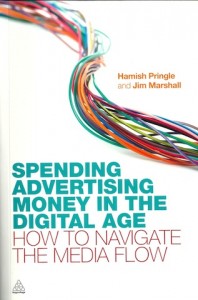The one-sentence summary
In the digital age, a minimum of three media are advisable in a campaign to catch people as media and data flow through their lives (the most successful campaigns now average nine).
WHAT THE BOOK SAYS 
- The title is a nod to Simon Broadbent’s 1970 book Spending Advertising Money
- It is a primer for all things media, based on how media and data flow through our lives (the book is subtitled How To Navigate The Media Flow)
- It contains stacks of research to explain today’s media landscape, and how to deploy communication funds in the most effective way on behalf of brands
- A review of the evolution of the media agency is followed by an overview of the UK’s media market, how to make media funds work more effectively, and a pitch for the strength of each medium from the people that head them up
WHAT’S GOOD ABOUT IT
- The strategic advice is spot on:
1. Objectives: An objective begins with the word ‘to’ and a strategy begins with ‘by’
2. Sacrifice: Working out what you won’t do is crucial
3. Judgement and Intuition: Diagonal thinking combines lateral and linear approaches
4. Executability: The strategy is useless if it is too fanciful
5. Integration: the average number of media used by successful campaigns has risen from 2.4 to 9.1 since 1980
- The Theory of Three: consumers can usually trace back to three touch points that made them buy, such as ‘saw the book advertised, saw someone reading it on the train, saw a poster’. This could be any triangulation of stimuli.
- FAIPA is a new planning model:
Fame: awareness and salience
Advocacy: testimonials, reviews and word of mouth
Information: the brand’s functional performance
Price: cost, special offers, and value to the customer
Availability: where and when you can get the product
- Faris Yakob’s Transmedia Planning concept brings the whole thing up to date, explaining the benefit of encouraging audiences to share elements of the brand narrative by generating their own communities and conversations – this is non-linear and cannot be controlled by brands
WHAT YOU HAVE TO WATCH
- Although well-informed, from time to time it slips into sounding like a brochure for the IPA (Institute of Practitioners in Advertising), who provided much of the data
